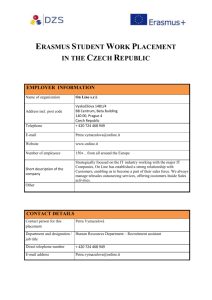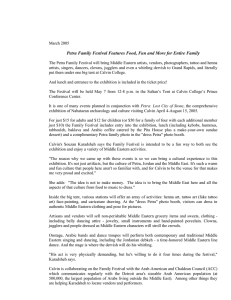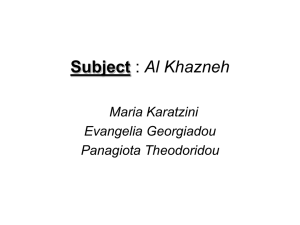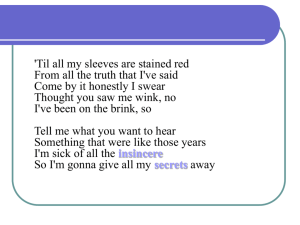STUDENT PROGRAMS AT CALVIN COLLEGE’S PRINCE CONFERENCE PETRA: LOST CITY OF STONE
advertisement
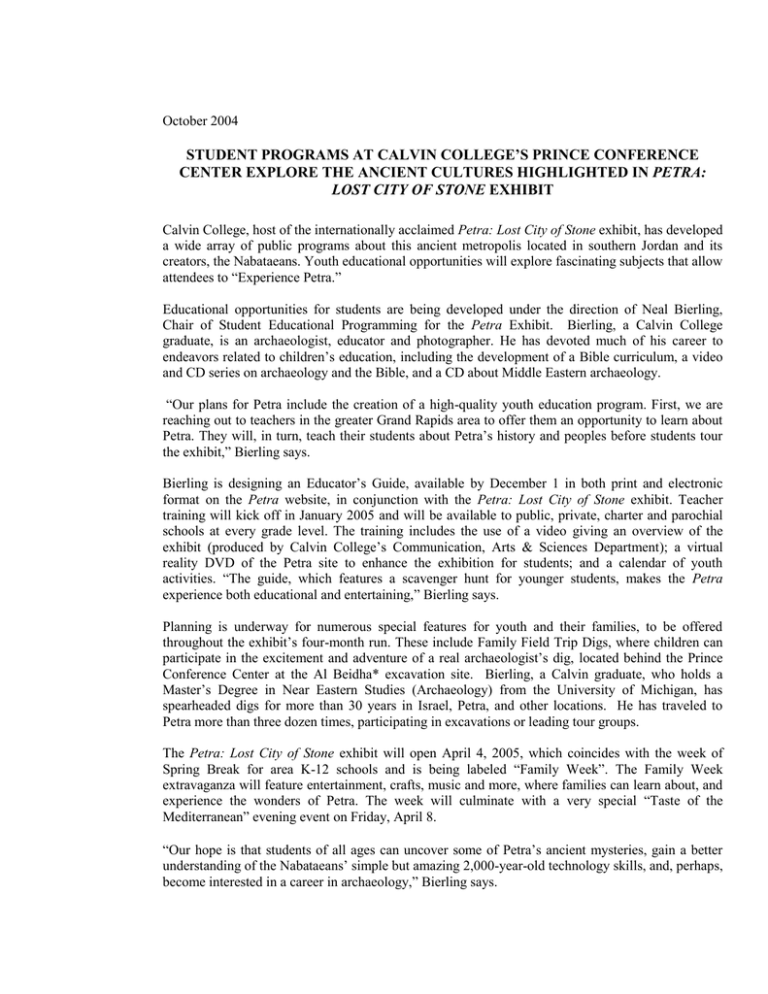
October 2004 STUDENT PROGRAMS AT CALVIN COLLEGE’S PRINCE CONFERENCE CENTER EXPLORE THE ANCIENT CULTURES HIGHLIGHTED IN PETRA: LOST CITY OF STONE EXHIBIT Calvin College, host of the internationally acclaimed Petra: Lost City of Stone exhibit, has developed a wide array of public programs about this ancient metropolis located in southern Jordan and its creators, the Nabataeans. Youth educational opportunities will explore fascinating subjects that allow attendees to “Experience Petra.” Educational opportunities for students are being developed under the direction of Neal Bierling, Chair of Student Educational Programming for the Petra Exhibit. Bierling, a Calvin College graduate, is an archaeologist, educator and photographer. He has devoted much of his career to endeavors related to children’s education, including the development of a Bible curriculum, a video and CD series on archaeology and the Bible, and a CD about Middle Eastern archaeology. “Our plans for Petra include the creation of a high-quality youth education program. First, we are reaching out to teachers in the greater Grand Rapids area to offer them an opportunity to learn about Petra. They will, in turn, teach their students about Petra’s history and peoples before students tour the exhibit,” Bierling says. Bierling is designing an Educator’s Guide, available by December 1 in both print and electronic format on the Petra website, in conjunction with the Petra: Lost City of Stone exhibit. Teacher training will kick off in January 2005 and will be available to public, private, charter and parochial schools at every grade level. The training includes the use of a video giving an overview of the exhibit (produced by Calvin College’s Communication, Arts & Sciences Department); a virtual reality DVD of the Petra site to enhance the exhibition for students; and a calendar of youth activities. “The guide, which features a scavenger hunt for younger students, makes the Petra experience both educational and entertaining,” Bierling says. Planning is underway for numerous special features for youth and their families, to be offered throughout the exhibit’s four-month run. These include Family Field Trip Digs, where children can participate in the excitement and adventure of a real archaeologist’s dig, located behind the Prince Conference Center at the Al Beidha* excavation site. Bierling, a Calvin graduate, who holds a Master’s Degree in Near Eastern Studies (Archaeology) from the University of Michigan, has spearheaded digs for more than 30 years in Israel, Petra, and other locations. He has traveled to Petra more than three dozen times, participating in excavations or leading tour groups. The Petra: Lost City of Stone exhibit will open April 4, 2005, which coincides with the week of Spring Break for area K-12 schools and is being labeled “Family Week”. The Family Week extravaganza will feature entertainment, crafts, music and more, where families can learn about, and experience the wonders of Petra. The week will culminate with a very special “Taste of the Mediterranean” evening event on Friday, April 8. “Our hope is that students of all ages can uncover some of Petra’s ancient mysteries, gain a better understanding of the Nabataeans’ simple but amazing 2,000-year-old technology skills, and, perhaps, become interested in a career in archaeology,” Bierling says. 2 The Petra: Lost City of Stone exhibit was organized by Cincinnati Art Museum and American Museum of Natural History, New York under the patronage of Her Majesty Queen Rania Al-Abdullah of the Hashemite Kingdom of Jordan. Air transportation generously provided by Royal Jordanian. For more information about the Petra: Lost City of Stone exhibit, running April 4 – August 15, 2005, at the Prince Conference Center, contact Calvin College at 3201 Burton S.E., Grand Rapids, MI 49546; 616.526.7800; 800.PETRA05; or log on to www.calvin.edu/petra. Exhibit hours: M/W/F/Sat., Memorial Day and Fourth of July, 9:30am-6pm; T/TH, 9:30am – 9pm; Closed Sunday. -end- ______________________________________________________ For Release: October 2004 Calvin College Phil deHaan Director of Media Relations 616.526.6475 dehp@calvin.edu Professional Marketing Diane M. Jones President 616.949.9104 pmconsulting@aol.com ______________________________________________________ [*Al Beidha = “The White One”] About Petra and Petra: Lost City of Stone: Petra: Lost City of Stone is the first major cultural collaboration between Jordan and the United States. This groundbreaking exhibition offers North American audiences the opportunity to learn about the ancient metropolis of Petra, which was literally carved from the red sandstone in the desert cliffs of southern Jordan. Located in the Jordan Rift Valley at the crossroads of international trade routes, Petra was one of the most influential and prosperous commercial centers in antiquity. The rich cultural life of the city reflected a confluence of Eastern and Western styles and traditions. The forbidding desert was transformed by the Nabataeans into a bustling metropolis with monumental tombs carved directly into the red sandstone hills, and hundreds of other structures including burial chambers, funerary banquet halls, residences, theaters, bath complexes, arched gates and a complex system of water channels and reservoirs. The Nabataeans were skilled engineers and developed and maintained an elaborate system of damming, terracing and irrigation that allowed them to maximize the agricultural potential of the surrounding Petra plateau. From the second century B.C. through the third century A.D., Petra prospered. A massive earthquake in A.D. 363 destroyed much of the city, and, although partially revived after that, Petra was no longer the economic powerhouse it had been. Much of the technological infrastructure that had made life in Petra possible fell into disuse, and political and religious changes in the ancient world led to the eventual abandonment of the city in the seventh century A.D. From its rediscovery by Swiss explorer Johann Burckhardt in 1812, Petra, with its savage beauty, desolate setting, the mystery and splendor of its rock-carved architectural ruins and the variegated color of its cliff faces, has been a source of deep fascination for Westerners. It became a major pilgrimage site for 19th century European and American artists and other travelers, and it continues to enthrall. It was even used as a location for the popular 1989 feature film Indiana Jones and the Last Crusade. About Calvin College Founded in 1876, Calvin College has become one of the largest Christian colleges in North America with over 4,000 students from the U.S., Canada and another 50 countries around the globe. Calvin College offers nearly 100 majors and areas of study and has 10 off-campus program options for students, including such places as China, Ghana, and Honduras. Calvin is widely recognized for its outreach by means of scholarly study and works of art by its faculty and by student and alumni service in their various communities. Special events also broaden Calvin’s outreach. Among them is the biennial Conference on Faith and Writing, which brings noted writers to campus, and the annual widely-recognized January Series, a 15-day educational and cultural series, which brings to campus internationally recognized musicians and scholars on timely topics. The archaeological exhibit Petra: Lost City of Stone is brought to Calvin College as part of its dedication to community education and outreach.
